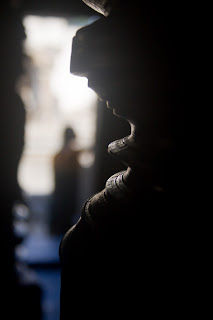Yercaud got its name from the Tamil words, yeri and kaadu, meaning lake and forest respectively. The British discovered it in the early 19th century. There are accounts of coffee plantations being introduced by a British officer in the area in the second decade of the 19th century.
Sun rise in Yercaud
Yercaud Town is situated above 4800' from mean sea level.
On the way to Yeraud, there are 20 hairpins and it is a tough ride up the hill. We can see beautiful scenery of the mountains coming out of the clouds....
Shevaroy Temple
The highest point in Yercaud Taluk is Shevaroy Temple which is situated at a height of 5326'. Hence, Yercaud hill area is called "Shevaroyan Hills". It is also called "Ooty of the Poor". This is the third highest range in this part with a modern cave temple at its top. The hill top is bald with a real open view of all the hills around.
I was not able to get a good picture of the temple but the picture below is the back side of the temple
Killiyur Falls
The water is from the Big Lake that connects to the falls through a stream. A long walk through the enchanting woods takes you to Killiyur Falls.
Kiluyur water falls had a small water fall when we went but during the months of Nov - Dec we can see excess waters of the Yercaud lake and the other reaches of the Shevaroyan Hills and falls deep into the Kiliyur Valley at 300 feet.
Lady Seat
One of the best views that Yercaud promises.You get a panoramic view of the ghats and all the distant vehicles dwindling their way in and out of trees along the winding ghat road.It surely is a breath-taking view. You can have a closer view of the plains below with the help of the telescope mounted at the Lady's Seat.
When we went to Lady seat the clouds was all over and we had a heavy mist formation and the visibility was very less,.... Rose Garden
We happen to visit the Rose garden which is very near to Lady seat, the park is coming up very nicely, we have very little flowers in the parks and going forward if maintained properly - this could become a park similar to Ooty
How to reach Yercaud by train:
Ideal would be to take the Yercaud Express from Chennai. Salem is 335 km from Chennai on the main railway line. Salem Junction is 36 Kms away from Yercaud and 33 kms from Salem Town. All south bound trains passing via Salem do stop over at Salem.






















































